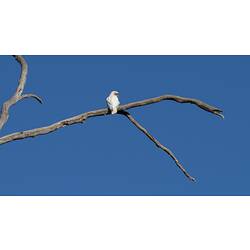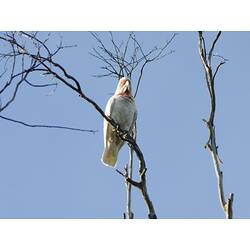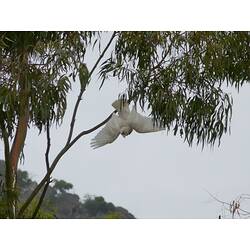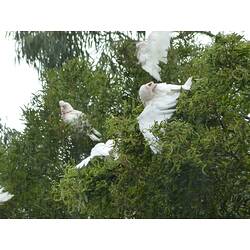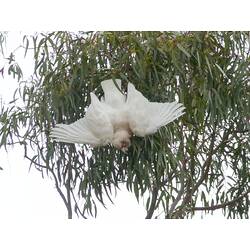General Description
A medium-sized white cockatoo with a short crest (not always visible), short tail, stocky body and a distinctive long upper bill. Faint yellowish wash on the undersides of its wings and tail; orange-red splashes on its forehead and throat; and an orange-red crescent across its upper breast. Eye ring is pale grey-blue. Body length up to 41 cm. Call a loud, quavering, two-syllable 'wulluk-wulluk' or 'cadillac-cadillac', as well as a harsh screech.
Biology
The Long-billed Corella is a conspicuous and gregarious bird. They are often seen foraging in large flocks on the ground. They form monogamous pairs and both parents prepare the nest, incubate the eggs and feed the young. Nests are made in the hollows of large old eucalypts, and sometimes in cavities of loose gravelly cliffs. The eggs are laid on a lining of decayed wood.
Distribution
South-eastern Australia
Habitat
Grassy woodlands and grasslands, including pasture and crops, as well as parks in urban areas.
More Information
-
Animal Type
-
Animal SubType
-
Brief Id
Medium-sized white bird with stocky body with a distinctive long upper bill and pale grey/blue eye ring.
-
Colours
White, Pink
-
Maximum Size
41 cm
-
Habitats
-
Diet
Omnivore
-
Endemicity
-
Commercial
No
-
Conservation Statuses
CITES: Trade restrictions (Appendix II), FFG Threatened List: Not listed, EPBC Act 1999: Not listed, IUCN Red List: Least Concern
-
Taxon Name
-
Scientific Author
(Kuhl, 1820)
-
Common Name
Long-billed Corella
-
Kingdom
-
Phylum
-
Subphylum
-
Class
-
Order
-
Family
-
Genus
-
Species Name
tenuirostris




